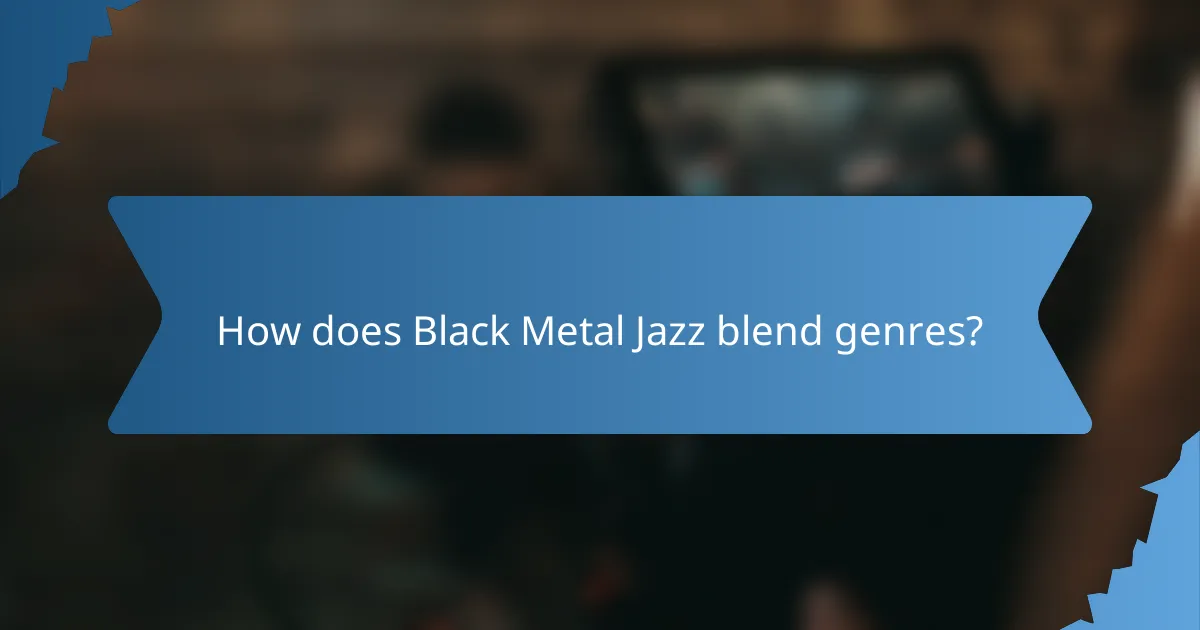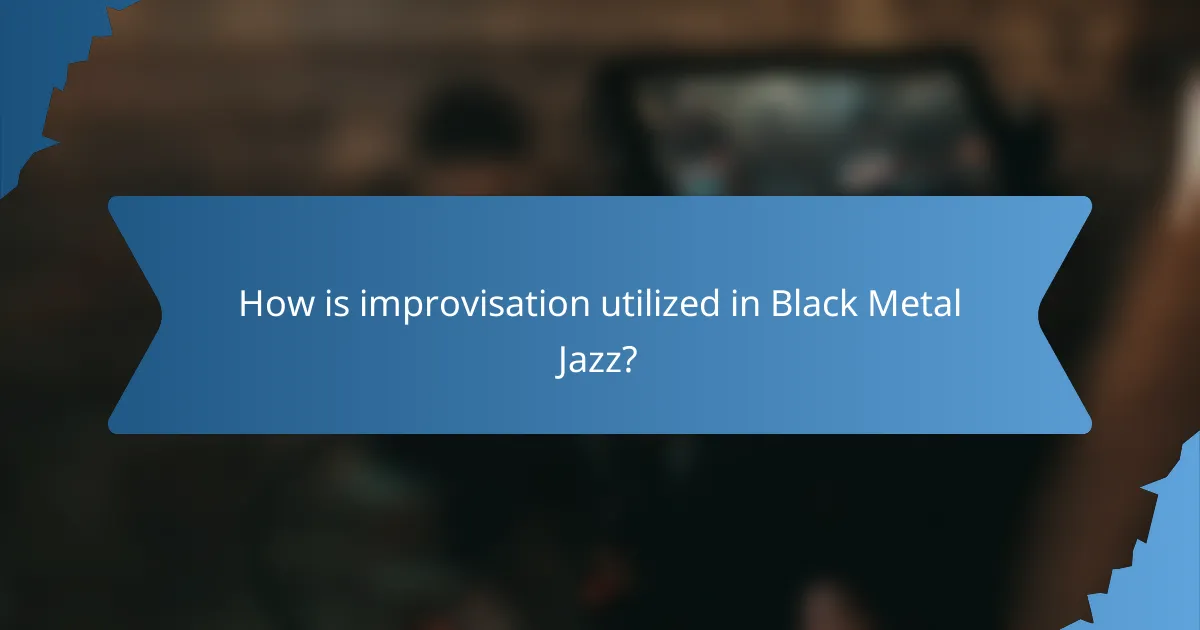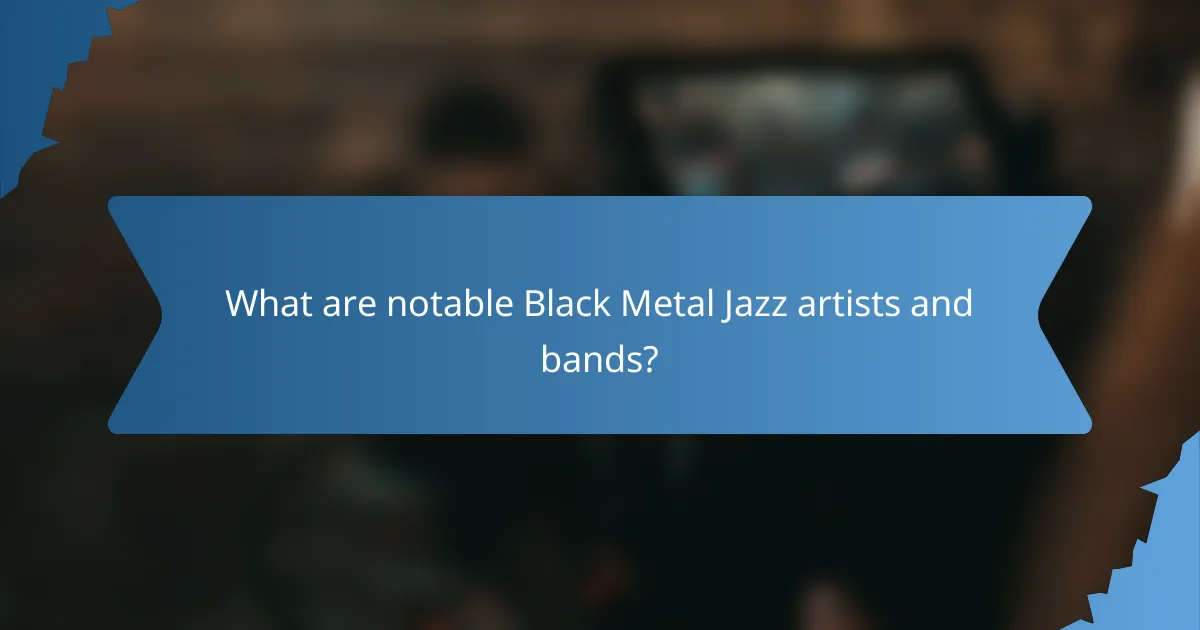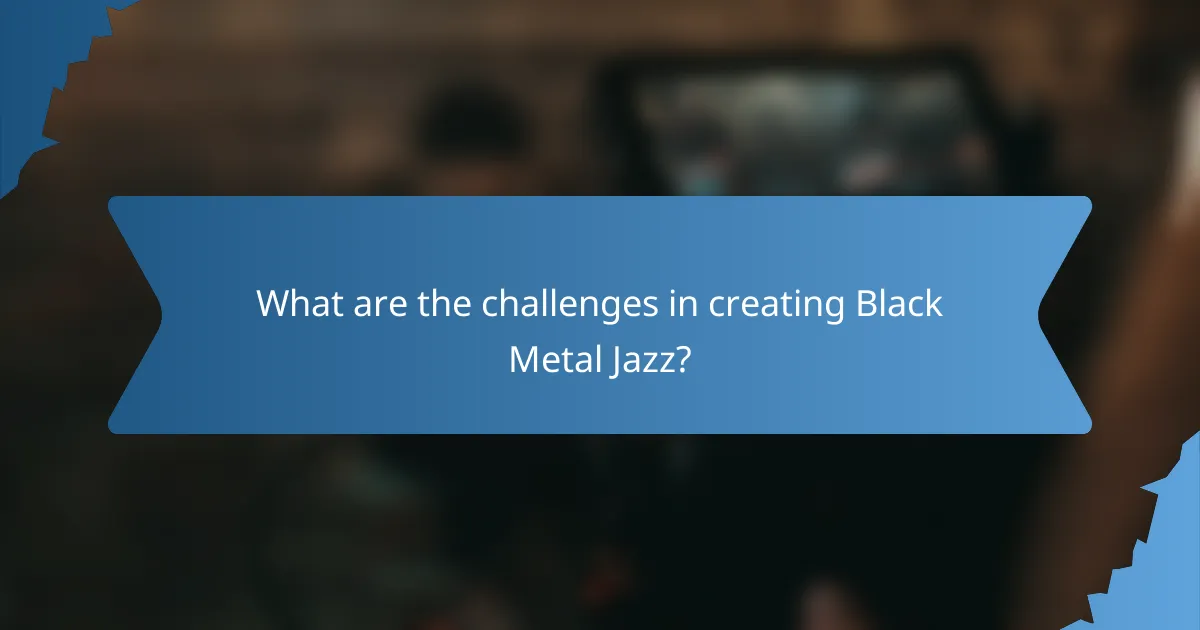Black Metal Jazz is an innovative genre that combines the dark, aggressive elements of black metal with the intricate improvisational style of jazz. This fusion results in a distinctive sound marked by heavy instrumentation, complex rhythms, and spontaneous performances that push the boundaries of both genres. Musicians in this realm embrace creativity, allowing for dynamic expressions and unexpected musical explorations.

How does Black Metal Jazz blend genres?
Black Metal Jazz merges the aggressive, dark aesthetics of black metal with the complex improvisational nature of jazz. This genre fusion creates a unique sound characterized by heavy instrumentation, intricate melodies, and spontaneous performances.
Fusion of black metal and jazz elements
The fusion of black metal and jazz elements results in a distinctive musical landscape. Black metal typically features fast tempos, shrieking vocals, and distorted guitars, while jazz brings in improvisation, swing rhythms, and intricate harmonies. The combination allows musicians to explore dark themes through both structured compositions and free-form playing.
For example, a typical Black Metal Jazz piece might start with a blast beat from the drums, transitioning into a jazz-influenced guitar solo that incorporates dissonant chords and unexpected time signatures. This interplay creates an engaging listening experience that challenges traditional genre boundaries.
Influence of improvisational techniques
Improvisational techniques are central to Black Metal Jazz, allowing musicians to express creativity and spontaneity. Unlike traditional black metal, where songs are often meticulously composed, this genre encourages performers to deviate from the score, creating unique interpretations during each performance.
Musicians often employ techniques such as call-and-response, where one instrument leads with a theme and others respond, adding layers of complexity. This approach not only enhances the live experience but also fosters collaboration among band members, resulting in a dynamic and evolving sound.
Unique rhythmic structures
Unique rhythmic structures are a hallmark of Black Metal Jazz, blending the aggressive rhythms of black metal with the syncopation and swing found in jazz. This creates a complex tapestry of beats that can shift rapidly, keeping listeners on their toes.
For instance, drummers might alternate between blast beats and intricate jazz patterns, while bassists provide a foundation that supports both styles. This rhythmic interplay allows for a wide range of emotional expression, from chaotic intensity to contemplative grooves, making each performance a distinct experience.

What are the defining characteristics of Black Metal Jazz?
Black Metal Jazz is a genre that fuses the aggressive, dark aesthetics of black metal with the improvisational and complex nature of jazz. This unique blend creates a sound characterized by intense emotional expression, intricate rhythms, and a focus on thematic depth.
Dark thematic content
The thematic content of Black Metal Jazz often explores existential dread, nature’s brutality, and the human condition, similar to traditional black metal. Lyrics and compositions may delve into topics like despair, isolation, and the macabre, creating a haunting atmosphere that resonates deeply with listeners.
Musicians in this genre frequently use literary and philosophical references to enhance their themes, drawing inspiration from authors like H.P. Lovecraft or Friedrich Nietzsche. This adds layers of meaning, inviting audiences to engage intellectually as well as emotionally.
Complex time signatures
Complex time signatures are a hallmark of Black Metal Jazz, setting it apart from more conventional genres. Musicians often employ irregular meters, such as 5/4 or 7/8, which challenge traditional rhythmic expectations and create a sense of unpredictability.
This complexity allows for greater improvisational freedom, enabling musicians to explore intricate patterns and syncopations. It’s common for a piece to shift time signatures multiple times, enhancing the dynamic quality of the performance and keeping the audience engaged.
Use of dissonance and atonality
Dissonance and atonality play a crucial role in shaping the sound of Black Metal Jazz. Musicians frequently incorporate unconventional chord progressions and intervals that create tension and unease, reflecting the darker themes of the genre.
This use of dissonance not only enhances the emotional weight of the music but also allows for creative improvisation. Musicians often experiment with atonal passages, pushing the boundaries of harmony and melody to evoke a visceral response from the audience.

How is improvisation utilized in Black Metal Jazz?
Improvisation in Black Metal Jazz serves as a core element, allowing musicians to create spontaneous and dynamic performances that blend the intensity of black metal with the fluidity of jazz. This genre encourages musicians to explore unique rhythms and unexpected musical directions, fostering an environment where creativity thrives.
Spontaneous composition techniques
Spontaneous composition techniques in Black Metal Jazz often involve musicians responding to each other’s cues in real-time, creating a fluid and evolving soundscape. Techniques such as call-and-response, where one musician plays a phrase and another responds, are common. Additionally, musicians might use motifs or themes that emerge during the performance, allowing for organic development of the piece.
Another technique is the use of structured improvisation, where musicians adhere to a loose framework or set of guidelines while still allowing for individual expression. This balance between structure and freedom is crucial for maintaining coherence in the music while enabling creativity.
Role of musicians’ interaction
The interaction between musicians in Black Metal Jazz is vital for effective improvisation. Each musician must be attuned to the others, listening closely to their contributions and adjusting their playing accordingly. This collaborative approach fosters a sense of unity and enhances the overall performance, as musicians build on each other’s ideas.
Moreover, non-verbal communication, such as eye contact and body language, plays a significant role in guiding the improvisational flow. Musicians often signal shifts in dynamics or tempo through subtle gestures, which can lead to unexpected and exciting musical developments.
Influence of jazz improvisation on performance
The influence of jazz improvisation on Black Metal Jazz performance is profound, as it introduces elements of spontaneity and personal expression. Jazz techniques such as syncopation, polyrhythms, and complex chord progressions enrich the black metal foundation, creating a unique sound that stands out in both genres.
Additionally, jazz’s emphasis on individual interpretation allows musicians to showcase their unique styles within the ensemble. This blending of influences results in performances that are not only technically proficient but also emotionally resonant, captivating audiences with their unpredictability and depth.

What are notable Black Metal Jazz artists and bands?
Notable Black Metal Jazz artists and bands blend the aggressive elements of black metal with the improvisational and complex structures of jazz. This fusion creates a unique sound characterized by heavy instrumentation, unconventional rhythms, and experimental approaches to music.
Sun O)))
Sun O))) is known for their drone metal sound, which incorporates elements of black metal and experimental music. Their performances often feature extended improvisation, creating an atmospheric experience that challenges traditional musical structures.
Their albums, such as “Monoliths & Dimensions,” showcase a blend of heavy guitar riffs and ambient soundscapes, making them a significant influence in the Black Metal Jazz genre. Their live shows are particularly notable for their immersive quality, often incorporating visual elements that enhance the auditory experience.
Shining
Shining, a Norwegian band, merges black metal with jazz influences, creating a distinctive sound that is both aggressive and intricate. Their music often features complex time signatures and a mix of harsh vocals and melodic instrumentation.
Albums like “Blackjazz” highlight their ability to seamlessly integrate jazz improvisation with the intensity of black metal. Shining’s live performances are characterized by their unpredictable nature, often leading to unique interpretations of their studio recordings.
Blackjazz
Blackjazz is a genre-defining album by Shining that exemplifies the fusion of black metal and jazz. The album features a mix of heavy guitar work, jazz-inspired saxophone solos, and intricate drumming, showcasing the band’s innovative approach to genre blending.
This album has been influential in establishing the Black Metal Jazz sound, attracting listeners from both metal and jazz backgrounds. Its experimental nature encourages musicians to explore the boundaries of their respective genres, making it a cornerstone in the evolution of this unique musical style.

How can one start exploring Black Metal Jazz?
To begin exploring Black Metal Jazz, immerse yourself in its unique blend of aggressive black metal elements and the improvisational style of jazz. Listening to key albums, attending live performances, and engaging with online communities can enhance your understanding and appreciation of this innovative genre.
Recommended albums for beginners
Start with albums that showcase the fusion of black metal and jazz, such as “The Black Jazz” by the band Krallice, which combines intricate guitar work with improvisational elements. Another excellent choice is “The Way of All Flesh” by Gojira, which features complex rhythms and atmospheric layers that resonate with jazz influences.
For a more experimental approach, check out “Demon’s Dance” by the band Kayo Dot, which incorporates various jazz styles into their metal framework. These albums provide a solid foundation for understanding the genre’s unique characteristics.
Live performance venues in Australia
In Australia, several venues are known for hosting Black Metal Jazz performances. The Corner Hotel in Melbourne often features experimental acts and is a great place to catch live shows that blend these genres. Another notable venue is The Metro Theatre in Sydney, which regularly hosts a variety of metal and jazz fusion performances.
Smaller venues like The Black Bear Lodge in Brisbane also provide an intimate setting for discovering emerging artists in the Black Metal Jazz scene. Keep an eye on local listings for upcoming shows and events.
Online communities and resources
Engaging with online communities can significantly enhance your exploration of Black Metal Jazz. Websites like Reddit have dedicated subreddits where fans discuss albums, share playlists, and recommend new artists. Joining forums such as Metal Archives can also provide valuable insights and resources.
Additionally, platforms like Bandcamp and SoundCloud allow you to discover independent artists and their unique takes on the genre. Following playlists curated by enthusiasts on streaming services can help you stay updated on new releases and underground talent.

What are the challenges in creating Black Metal Jazz?
Creating Black Metal Jazz involves blending two distinct genres, which presents unique challenges in terms of musical structure, improvisation, and audience reception. Musicians must navigate the complexities of combining the aggressive elements of black metal with the fluidity of jazz, requiring a deep understanding of both styles.
Balancing Aggression and Improvisation
One of the main challenges is balancing the aggressive nature of black metal with the improvisational style of jazz. Musicians need to maintain the intensity characteristic of black metal while allowing space for spontaneous expression typical in jazz. This often requires careful arrangement and a willingness to experiment with dynamics.
Improvisation in this genre can lead to unpredictable outcomes, which may not always resonate with audiences familiar with traditional black metal or jazz. Musicians should be prepared for varying responses and be open to refining their approach based on audience feedback.
Rhythmic Complexity
Black Metal Jazz often incorporates complex rhythms that can be difficult to execute. Musicians must master various time signatures and syncopation to create a cohesive sound. This complexity can challenge performers, especially in live settings where precision is crucial.
To navigate these rhythmic challenges, musicians can practice with metronomes or backing tracks that emphasize the desired beats. Collaborating with skilled drummers who understand both genres can also help in achieving the right rhythmic balance.
Audience Reception
Another challenge lies in audience reception, as fans of black metal and jazz may have differing expectations. Black metal enthusiasts might prefer the raw energy and aggression, while jazz fans may seek intricate melodies and improvisation. Striking a balance that satisfies both groups can be difficult.
To engage a diverse audience, musicians can consider incorporating elements from both genres in a way that highlights their strengths. Hosting listening sessions or workshops can also help gauge audience preferences and foster a deeper appreciation for this unique blend.
